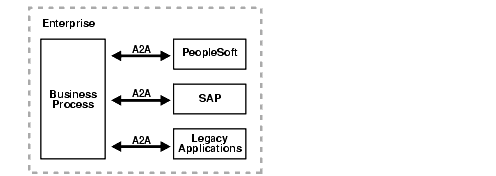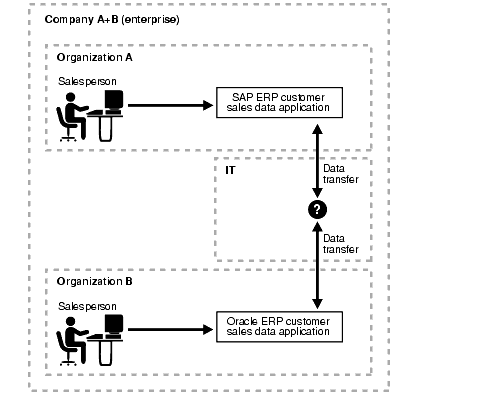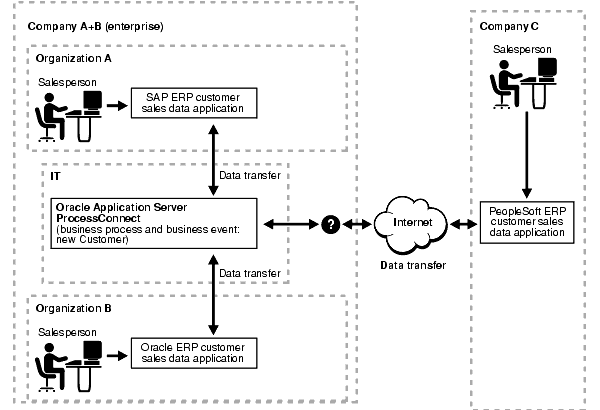10g (9.0.4)
Part Number B12121-01
Home |
Solution Area |
Contents |
Index |
| Oracle® Application Server ProcessConnect User's Guide 10g (9.0.4) Part Number B12121-01 |
|
This chapter defines e-business and integration challenges, and describes how Oracle Application Server ProcessConnect answers integration challenges.
This chapter contains these topics:
E-business is a method for improving your existing business processes by using Internet technologies within an enterprise and between enterprises. A key requirement for successfully automating e-business activities is integration technology. Integration technology enables:
Successful implementation of integration technology enables:
Two types of integration technologies are described throughout this User Guide:
A2A integration enables companies to integrate applications within the same company boundaries (known as an enterprise). The phrase integrations within an enterprise is used throughout this User Guide to describe this type of integration. Integration is managed by a business process. A business process spans all participants in an integration to coordinate sending and receiving data between applications. This management ensures that the correct applications send and receive data.
Figure 2-1 shows A2A integration.

B2B integration enables companies to extend A2A integration between enterprises to integrate trading partners with other trading partners. The phrase integrations between enterprises is used throughout this User Guide to describe this type of integration.
As with A2A, B2B integration is also managed by a business process that extends between enterprises to coordinate the data sent and received between trading partners. B2B integration uses a B2B protocol such as RosettaNet that provides guidelines for conducting business between enterprises. Figure 2-2 shows B2B integration.

The growth in the importance of e-business and integration technologies is based on business objectives such as the following:
Companies want to streamline online business systems to deliver products and services to customers. Automating business processes reduces costs and improves efficiencies. Integration automates processes and reduces the reliance on human interaction with phones, fax machines, and manual data updates to multiple applications.
Companies want quick access to the latest data from many information systems to better serve their customers and compete more efficiently. Better data is derived both by integration of many different systems to share data in a real-time manner and by having facilities to monitor and analyze business processes in real time.
Successfully enabling integrations within an enterprise and between enterprises presents major challenges. Integration challenges include the following:
Oracle Application Server ProcessConnect provides the following features for designing, deploying, monitoring, and maintaining integrations:
Oracle Application Server ProcessConnect provides a single product for designing, deploying, monitoring, and managing integrations within enterprises and between enterprises. Oracle Application Server ProcessConnect provides an overall architecture for integrating applications and integrating trading partners. The Oracle Application Server ProcessConnect user interface tool enables you to:
Figure 2-3 provides a high-level overview of Oracle Application Server ProcessConnect.

Oracle Application Server ProcessConnect enables you to integrate applications, legacy systems, and business partners that each use differing technologies and architectures. This includes applications such as SAP, PeopleSoft, J.D. Edwards, and Siebel; B2B protocols such as RosettaNet; and legacy mainframe applications.
Oracle Application Server ProcessConnect takes the differing terminologies and message structures of participating applications or B2B protocols and creates a business view of the data. This view, known as a business event, enables you to view and monitor the data sent and received between different systems in a common vocabulary. By defining a standardized business event, Oracle Application Server ProcessConnect also makes it easy to connect multiple applications together without needing to design point-to-point integrations between applications.
Oracle Application Server ProcessConnect enables you to create business processes that coordinate sending and receiving data. This management ensures that the correct parties send and receive data. Business processes also hide the unique characteristics of each party in an integration. Data is sent and received in the form of events. You can specify the business process to manage a specific event (for example, the arrival of a purchase order). You can also design the business processes separately, and associate them with the specific data to send and receive at a later time.
No code needs to be written to design an integration. The Oracle Application Server ProcessConnect user interface tool provides a modeling approach to creating integrations, which provides all the functionality required for designing, deploying, monitoring, and administering an integration. This enables you to fully concentrate on solving your business needs.
You create, validate, and deploy a configuration of an integration from a design to a production environment. You can monitor the status of a configuration through Oracle Enterprise Manager and create business reports that describe the configuration status
You can reuse components in additional integrations to reduce the duplication of effort required to create additional ones and the amount of retesting required
Oracle Application Server ProcessConnect addresses RosettaNet requirements by integrating with the Oracle E-Business Suite Supply Chain Trading Connector for RosettaNet module.
|
See Also:
|
This section provides high-level examples of integration challenges and how Oracle Application Server ProcessConnect answers these challenges.
This section contains these topics:
When companies consolidate through mergers and acquisitions, they must integrate their information systems to synchronize and share data between their billing systems and applications.
For example, a telecommunications company named Company A merges with a former competitor, Company B. Both companies become two separate organizations within a new company called Company A+B. Salespeople want to find information about the consolidated customer base for their regions. Both organizations use different applications for maintaining data about customers:
Figure 2-4 shows this environment.

Company A+B wants to integrate the systems of both organizations to enable them to communicate and share data. For example, if Organization B's salesperson adds customer data through their application, this data must be automatically published to Organization A. Currently, the only method for updating both is for Organization B's salesperson to send an e-mail to Organization A's salesperson requesting them to make manual updates through their application.
Company A+B faces many integration challenges, several of which are shown in Table 2-1.
Company A+B uses Oracle Application Server ProcessConnect to design and deploy an integration that operates between the two different systems. Figure 2-5 shows this integration.

Table 2-2 describes how Oracle Application Server ProcessConnect provides a solution to the integration challenges described in Table 2-1.
After designing and deploying the integration described in "Solution for Integrations Within an Enterprise: Oracle Application Server ProcessConnect", Company A+B starts subcontracting telecommunication projects in San Jose, California to Company C, a local, smaller company. Company C uses a PeopleSoft ERP application for customer data. Figure 2-6 shows this environment.

If Company A+B initiates a business transaction with a subcontractor in San Jose, Company C requires receipt of a purchase order request from the subcontractor.
Company A+B now faces new challenges in integrating their billing systems and applications with those of Company C, which is located outside their enterprise.
Table 2-3 describes several of the integration challenges.
Company A+B uses Oracle Application Server ProcessConnect to design and deploy an integration between their company applications and the trading partner, Company C. Figure 2-7 shows this integration.

Table 2-4 describes how Oracle Application Server ProcessConnect provides a solution to the integration challenges described in Table 2-3.
|
See Also:
Chapter 3, "Oracle Application Server ProcessConnect Concepts" for a detailed description of how Oracle Application Server ProcessConnect supports integrations within an enterprise and between enterprises |
This chapter defines A2A and B2B integrations. The challenges of integrations are identified, and how Oracle Application Server ProcessConnect addresses these challenges. A2A and B2B examples (using RosettaNet) are provided of how Oracle Application Server ProcessConnect integrates parties by defining a common view of the data.
|
|
 Copyright © 2003 Oracle Corporation. All Rights Reserved. |
|